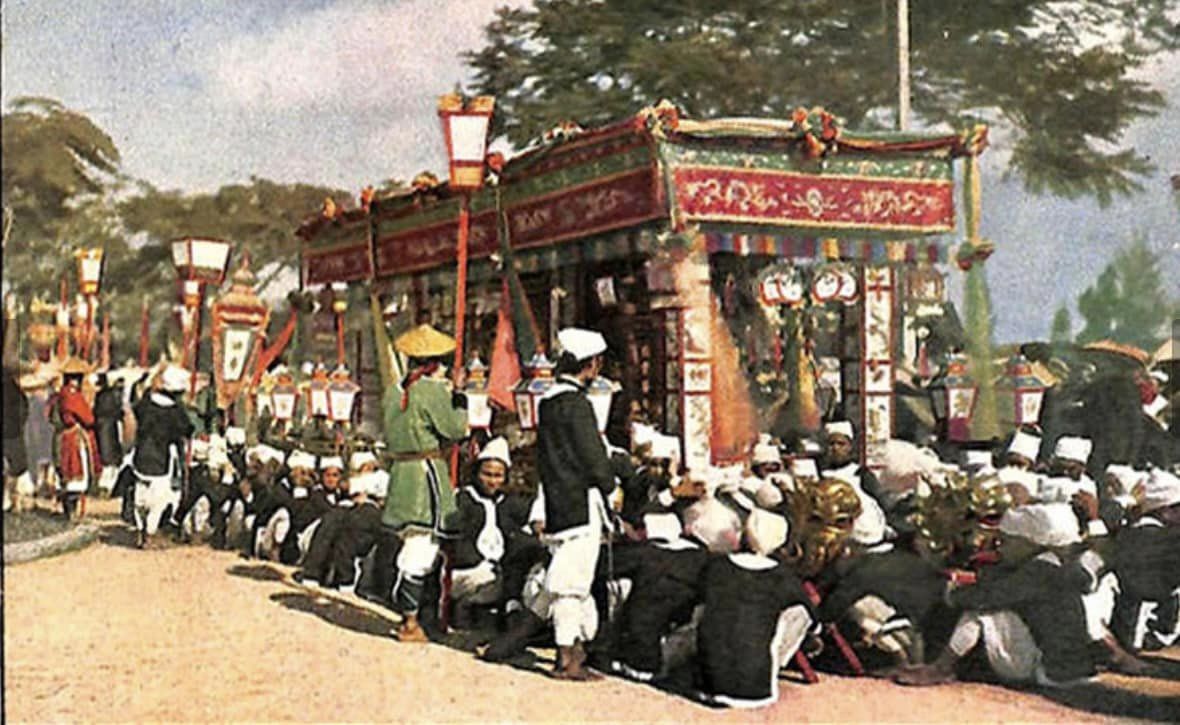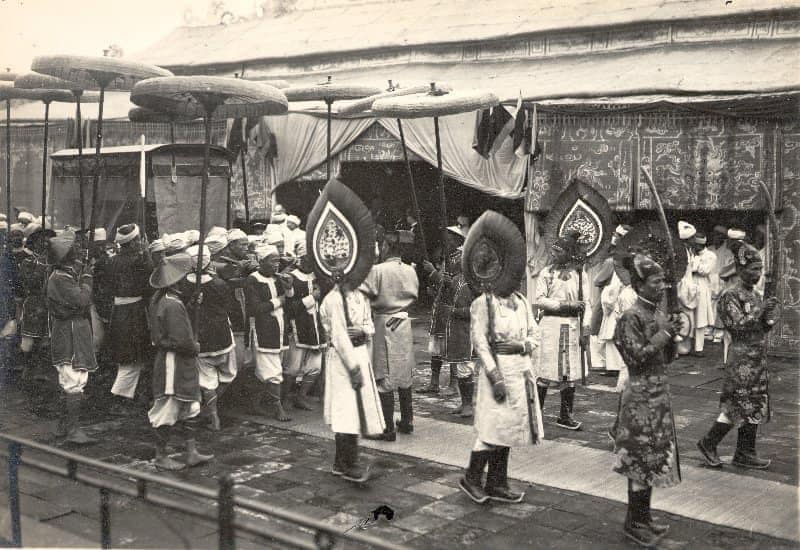After celebrating his 40th birthday for over a year, Emperor Khải Định passed away on November 6, 1925, due to pulmonary tuberculosis, one of the challenging diseases of that era.
Before his passing, in addition to his will, the emperor entrusted his 12-year-old heir, Crown Prince Vĩnh Thụy, to the Hue Resident Minister, Pasquier, for care.
On the afternoon of November 6, various herbal concoctions were used to cleanse the emperor's body. He was then dressed in new clothes. Nine pearls and nine grains of rice were placed in his mouth, and a golden cloth was placed over his face, secured behind his neck.
The mourning ceremony took place at 5 pm and 11 pm on that day, with the emperor's remains placed in the royal chamber (the royal coffin) in the Can Chanh Palace, facing south.
Following Emperor Khải Định's passing, the Royal Astrologer was tasked with determining auspicious dates for the mourning period, which would influence important funeral rites (Bulletin of the French School of Asian Studies (BEFEO) No. 26/1926).
The ceremony for resurrecting the emperor was scheduled for the Hour of the Monkey (3 - 5 pm) on November 17, 1925, which was 11 days after Emperor Khải Định's passing. A eunuch invited two empress dowagers to receive mourning attire and guided them in the mourning rituals. An official from the Ministry of Rites, dressed in mourning attire, approached the throne and placed a white silk sash with large knots symbolizing the departed's soul. Those in attendance knelt as directed by the officiating official. When the resurrection ceremony concluded, everyone withdrew. A palace guard respectfully invited the two empress dowagers and the consorts of the late emperor to pay respects at the royal shrine. Then, it was the turn of the consorts of other emperors, princesses, and chief consorts of high-ranking officials.
As per Emperor Khải Định's will, the mourning period for royal family members and court officials was shortened. The empress dowagers mourned for six months, and Crown Prince Vĩnh Thụy, aged 15 instead of the traditional 27, for 15 months. Mourning attire also changed to either white, with a thick cord, or black with a white kerchief. The use of pink and purple clothing was prohibited for 100 days, and during the waiting period for burial, weddings and singing were prohibited.
Upon the recommendation of the Royal Astrologer, the burial ceremony was scheduled for January 29, 1926, nearly three months after Emperor Khải Định's passing. During this time, the royal chamber remained at the Can Chanh Palace, where daily ceremonies were conducted under the responsibility of the mourning committee, officials from the Ministry of Rites, and palace guards.
On January 8, 1926, while the traditional mourning rites continued, the funeral ceremony for Crown Prince Vĩnh Thụy, who adopted the title Bảo Đại, took place at the royal court. Officials donned grand court attire according to the customary rituals, and the event was attended by the Resident Minister of Annam Alexandre Varenne. Subsequently, new mourning envoys were escorted to the throne to pay homage to the royal family.
Twenty-one days after the funeral ceremony for Emperor Bảo Đại, on January 29, 1926, the burial ceremony for Emperor Khải Định began. On that morning, the palace gates were sealed, with only the Resident Minister of Hue, Khâm sứ Huế, and a few high-ranking French officials arriving to pay respects to the royal family and accompany the funeral procession.

As per the program, the emperor's casket was moved from the palace to its burial site in the village of Chân Chữ, Hương Thủy District, Thừa Thiên Province, over two days. Floral altars were set up along the route by the local communities, and elders knelt as the funeral procession passed. The 6-ton golden house placed over the casket was carried by 160 strong individuals who moved with precision, without spilling a drop from the wine glasses placed on their garments. There were no musical accompaniments; instead, women mourners remained in the capital, and the procession moved in silence, a poignant and reflective moment of remembrance for a bygone era.
That night, the procession halted at Nam Giao Temple. This was the site where Emperor Khải Định visited every three years to perform the Giao rites, a traditional ceremony dating back to the 12th century.
On the morning of January 30, 1926, the funeral procession continued, and that night, the emperor's casket was placed in the burial chamber. The burial rituals had been conducted the previous day. Emperor Bảo Đại, the empress dowagers, and consorts of the late emperor concealed themselves behind a golden curtain in the burial chamber. To the right were French women and wives of Vietnamese officials, and to the left were French officials. After a minute of silent reflection, the Resident Minister of Annam, Varenne, delivered a brief eulogy praising the deceased emperor, a friend of France who "honored the past, understood the present, and prepared for the future" (BEFEO - No. 26/1926 - sđd - p. 504).

Subsequently, an official from the Ministry of Rites knelt to ask the late emperor's permission for burial. The burial clothes were removed from the casket, revealing the emperor's remains, and items made of paper and the emperor's clothing were burned. This marked the end of one of the relatively simple royal funerals in the Nguyen Dynasty. Khai Dinh Tomb, also known as Ung Lang (應陵) is the tomb of Emperor Khai Dinh (1885-1925), the 12th Emperor of the Nguyen Dynasty, located on the slopes of Chau Chu mountain (also known as Chau E) outside Hue capital city, now belongs to Thuy Bang commune, Huong Thuy town.
After the funeral, at the age of 13, Emperor Bảo Đại continued his education in France, and the regency in the court was led by Queen Mother Từ Cung (Hoàng Thị Cúc) and the Chief Royal Advisor Tôn Thất Hân.